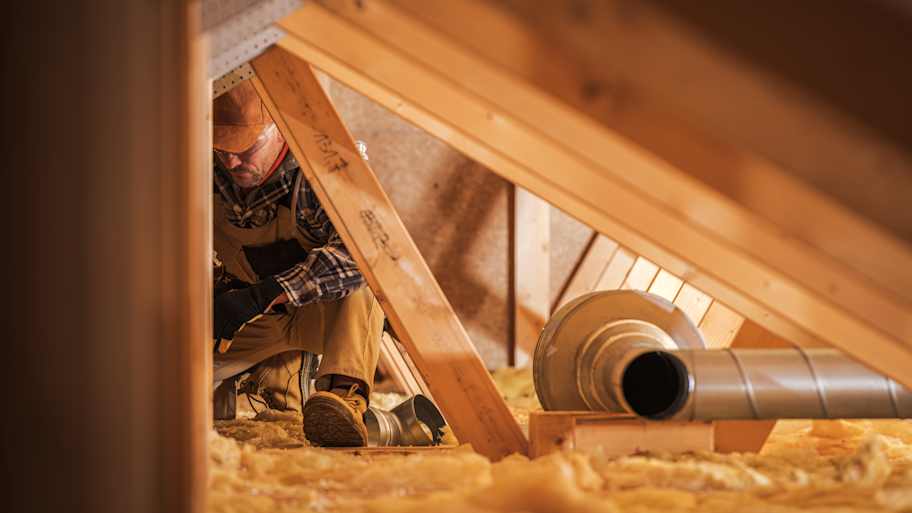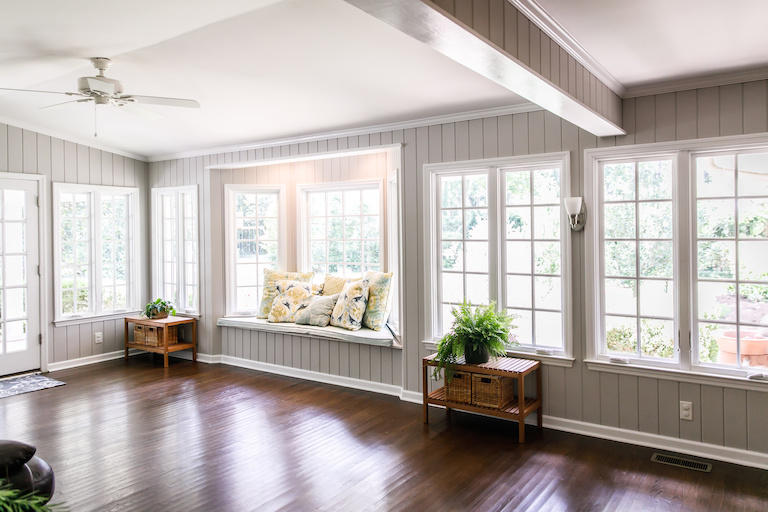
Before you hire a licensed electrical contractor, you should learn the cost to run electric from the road to your house so you can budget for the project.
These will make you a fan of fresher, cooler air


A whole-house fan draws cool, outdoor air into your home and circulates it.
An attic fan forces warm and humid air outdoors through roof and attic vents.
Whole-house fans cost more to install than attic fans but deliver a higher ROI.
With proper installations, attic fans reduce humidity in your living space.
You can run both attic fans and whole-house fans at the same time.
Using fans to move air throughout the house can help you maintain comfortable temperatures and avoid excessive humidity. When considering installing a whole-house fan versus an attic fan, think about what you want to accomplish with the equipment. Both types of fans help with cooling the house, but they have different functions. Learn more about the pros and cons of whole-house and attic fans.
When comparing whole-house fans versus attic fans, a whole-house fan cools the entire living space, while an attic fan focuses on moving air out of the attic through roof vents.
Attic fans appear more frequently in homes than whole-house fans. You can have both types of fans installed, though. If someone has a whole-house fan, they probably also have an attic fan. However, if you only have one or the other, attic fans are far more likely to be the standalone installation.
Whole-house fans draw cooler air in from outdoors and distribute it throughout the home. The warmer air in the house naturally rises—replaced by the cooler air—until it reaches the attic. It eventually flows out of the house through the attic roof vents.
| Pros | Cons |
|---|---|
| More energy efficiency | Possible noisy operation |
| Reduced need for AC | Costly installation |
| Fresher air quality | Not for all climates |
Best for:
Homes in areas where windows can be open at night
People who want to lower their air conditioning bills
Those who want to reduce the humidity levels in the house
When you install a whole-house fan, you can reduce the need to run your air conditioning system, which should lower your energy bills. The fan draws cool air from outdoors and distributes it throughout the home. Attic fans only focus on moving air in and out of the attic, an area where you likely don’t have air conditioning vents.
Because the whole-house fan pushes warm air from inside the residence upward and into the attic, its operation should improve indoor air quality. You may notice fewer musty odors, less humid air, and a fresher smell in the home.
The cost of installing a whole-house fan can be double or triple the cost of installing an attic fan. The whole-house fan requires more intensive labor, and you might need to remove parts of the walls or ceilings.
If you live in an area where extremely cold or hot weather makes it difficult to leave windows open, the whole-house fan will not be effective. This device is also not helpful if you can’t open windows at night because of security reasons or a noisy neighborhood. Some whole-house fans run quietly, while others can generate significant noise, disturbing your sleep.

Attic fans are ventilation devices installed in your home’s attic. They move warm, humid air out of the attic through roof vents. When operating attic fans during the summer months, you will need to run the air conditioner less, reducing your energy bills. Attic fans can run from hard-wired electricity or solar panels. They work well as a standalone fan or when running together with a whole-home fan installation.
| Pros | Cons |
|---|---|
| Low installation cost | May run noisily |
| Improved air quality | Pressure issue worries |
| Lower humidity levels | Won’t cool living areas |
Best for:
Homes in climates with high temperatures and humidity
Attics with proper sealing and ventilation installed
Houses that have air conditioning systems running
Among the pros and cons of attic fans is the benefit of the significantly lower installation cost compared to a whole-house fan. You can expect to pay $400 to $900 when hiring a local attic fan installation professional for this job.
You should notice lower humidity levels in the house as the attic fan forces warm, humid air out of the roof vents. This means your air conditioner should not have to run as frequently. Moving stale, damp air out of the attic improves the odor of the air inside the house, too.
The most significant disadvantage to operating an attic fan is the possibility of creating negative pressure. If the installer makes an error with the fan, or if you have improper sealing or ventilation in the attic, the attic fan can pull air too aggressively out of the living spaces inside the house. Negative pressure issues can affect natural gas appliances and draw toxic combustion gases into the living area.
Some attic fans generate extra noise as they operate, which could disturb you if you’re trying to sleep in a bedroom near the fan. To make the attic fan as efficient as possible, you need air conditioning running in your living areas, as the attic fan does not cool the home.
When deciding whether to install a whole-house fan, an attic fan, or both, it’s helpful to compare the two options head-to-head.
Homeowners can customize their whole-house fans with features like airflow adjustments, speed control, and insulation that reduces noise. If you need an unusual installation, a professional can adjust the fan’s configuration. Attic fans are customizable, too, but the features are often limited to aesthetics and remote control options.
One benefit of attic fans is that homeowners can install them and forget about them. They run efficiently and without the need for intervention for 10 to 15 years. Whole-house fans give homeowners 10 to 15 years of performance with little need for adjustments.
A whole-house fan installation can cost double or triple that of an attic fan. Whole-house and attic fans both have a low cost of operation, although attic fans can cost even less to run if you use a solar-powered model.
Although some people may try installing attic fans and whole-house fans themselves, it’s almost always better to hire a professional. Installations can be tricky, requiring you to work with electrical wiring. You may need to work inside a cramped attic, along a roofline, or inside walls and ceilings.
Because the attic fan covers a smaller area, it’s easier to install than a whole-house fan. You may have to open walls and ceilings to install a whole-house fan.
Both attic fans and whole-house fans are simple machines, meaning they are easy for professionals to repair and maintain.
Installing attic and whole-house fans can both provide energy-efficiency benefits that make them eco-friendly devices. When you install one or both of these fans, you can run your air conditioner less often.
Because they reduce the need to run your air conditioner more effectively than attic fans, whole-house fans deliver a better return on investment (ROI). Attic fans help with some energy savings, but they can’t deliver the same ROI as a whole-house fan.
When you install a whole-house fan, you may see a slight increase in home sale value.
From average costs to expert advice, get all the answers you need to get your job done.

Before you hire a licensed electrical contractor, you should learn the cost to run electric from the road to your house so you can budget for the project.

Whether you’re shopping for a new home or simply doing a safety check on your current place, learn what factors influence an electrical inspection cost.

Old or worn electrical wires can interrupt the electrical supply to your home. Find out the cost to replace the wire from the meter to the breaker box.

Planning out a 50-amp circuit? Selecting the right wire size is crucial. Find out how to determine the right 50-amp wire size.

Grounded circuits are happy (and safe) circuits, but what if you live in an older home with pre-grounded receptacles? Here are ways to ground without a wire.

Wondering who to hire for electrical work on home additions? Compare electricians and electrical contractors to see how pros get the job done.